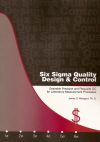Advanced Quality Management / Six Sigma
Six Sigma: Quality Design and Control Processes
Six Sigma tells us that well-designed processes will reduce waste, boost efficiency, and increase profits. But how do we "design well" in the laboratory? How do we convert our customer feedback into useful quality requirements and method specifications. Dr. Westgard provides step-by-step guidelines, graphic tools, and advice. (preview)
- Analytical quality - an essential characteristic
- Quality requirements
- Analytical quality requirements
- Clinical quality requirements
- Quality design and control applications
- Design process for method specifications
- Design process for QC specifications
- Tools and technology
- References
It is a basic principle of Six Sigma Quality Management that well-designed processes are critical to achieving quality. It also follows that there must be a design process that has been carefully structured to plan the quality of new products or services. One well-established approach to process and product design is called Quality Function Deployment (QFD) [1]. QFD is often described as process for translating customer needs into product and production specifications.
The idea of translation suggests the difficulty of understanding customer needs and relating them to product and process specifications. Customers and producers seldom speak the same language, therefore the needs of the customer require interpretation in order to become specifications for products and production processes. This is clearly true when discussing the analytical quality of laboratory tests. Physicians and patients want correct results. Manufacturers are concerned with the imprecision and inaccuracy of their methods and systems. Laboratory analysts are concerned with quality control, as well as the imprecision and inaccuracy of the method. The customers' needs for correct results must be translated into specifications for the imprecision and inaccuracy of a method, as well as the quality control rules and the numbers of control measurements needed to monitor the testing process in a laboratory [2].
Analytical quality - an essential characteristic
Quality design in a laboratory must begin with analytical quality because it is the essential quality characteristic of any laboratory test. It's not the only quality characteristic, but unless analytical quality can be achieved, none of the other characteristics matter. For example, turnaround time is an important quality characteristic, but it doesn't matter how fast the result is reported if the result is wrong. The laboratory must first be able to produce a correct test result before any other quality characteristic becomes important.
A detailed step-by-step planning process is needed to properly consider the critical factors that affect the quality of laboratory test results. Analytical quality is a particularly complex characteristic, involving the imprecision, inaccuracy, and instability of a measurement procedure, as well as the error detection and false rejection characteristics of a statistical QC procedure. Six Sigma texts seldom treat complex characteristics like analytical quality, which is the reason for providing a detailed quality design and control process here.
When focusing on quality design and control for laboratory applications, people will have different interests related to their own jobs.
- If you are a laboratory director, manager, or quality coordinator, your first interest may be to satisfy regulatory and accreditation guidelines for planning your testing processes. A rigorous and well-documented process will be important. Selecting control rules and numbers of control measurements is, of course, an important application in a service laboratory. In addition, performance specifications for methods can also be determined for preferred QC procedures, which should be useful in establishing purchase specifications for methods, instruments, and systems.
- If you are a manufacturer, your interest may be in establishing performance specifications for the precision and accuracy by a quantitative design process. You may also need to develop QC instructions that take into account regulatory quality requirements, the design specifications for imprecision and inaccuracy, and the common QC practices in the marketplace.
- If you are a regulatory analyst, you may need to assess the practicality of proposed proficiency testing criteria by comparison of analytical and clinical requirements for quality. Manufacturer's QC product labeling should be reviewed to assess whether those QC instructions are valid for the intended use. Laboratory QC practices should be reviewed to assess whether they are valid to assure the quality needed for the patient populations and clinical applications in a healthcare organization.
 Want to read more of this article?
Want to read more of this article?
We invite you to purchase the Six Sigma QC Design and Control manual, Second Edition, available at our online store. You can also download the Table of Contents and a Sample chapter.
